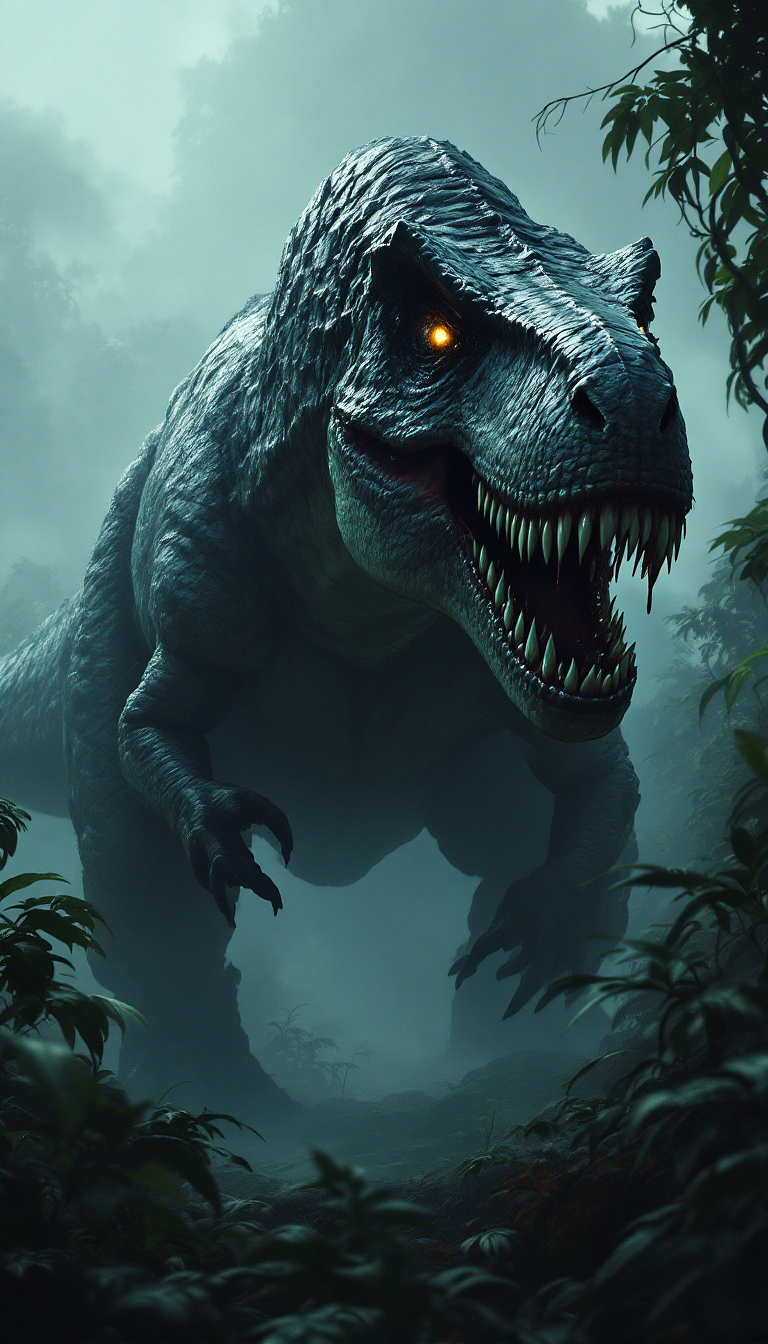

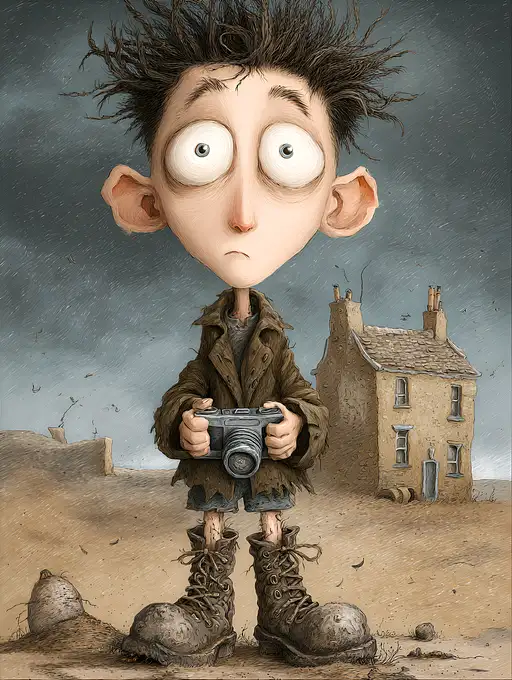
5 months ago
funny caricature, haunted young boy caricature, young caucasian male, 10 years old, with wide eyes, pale skin, ragged clothes, big cartoonish head, exaggerated caricature features, startled expression, wearing dirty brown jacket, oversized boots, holding a camera, claymation caricature style with textured details, textured details, muted colors, whimsical, playful, satirical, creepily captivating, abandoned house environment

8 months ago
A terrified woman stares downward at a swirling black vortex in the center of her stomach, her face frozen in an expression of fear and despair. The vortex distorts the surrounding flesh and fabric, pulling her inward with immense gravitational force. Her torso begins to twist and spiral unnaturally toward the vortex, her arms and head subtly warped as though drawn into an invisible event horizon. Skin and clothing fragment into streaks of light and shadow, trailing around the pull. Her hair is swept into the void, strands unraveling and disintegrating mid-air. Around her body, gravitational ripples warp the air, bending light and forming ghostly echoes of her disintegrating figure. The environment is dark and minimal, as if erased by the void, with surreal, dreamlike lighting—faint, cold illumination highlighting the curvature of her distorted form. Her terrified eyes reflect the infinite abyss within her, a haunting mix of desperation and acceptance. The scene captures a surreal emotional collapse—haunting, dreamlike, and deeply evocative. --v 1.1 --style ultra --quality 2 --ar 3:4

5 months ago
Create a hyperrealistic portrait of a mysterious African American lady, her piercing glacier blue eyes captivating the viewer. She stands in a dimly lit, shadowy environment, with minimal lighting that highlights her features while casting deep shadows. Employ hyper-realistic skin with a very detailed texture with intensity; the skin texture appears heavily embossed and the texture contrasts sharply and reacts intensely with light. the photo is shrouded with dark aura, haunting. Use extremely high contrast to enhance her features. Her skin color is heavily saturated. The background is black and blurred, enhancing the depth of field and emphasizing her presence. The color palette consists of dark blues, blacks, and subtle hints of silver, creating a haunting atmosphere. Employ a chiaroscuro technique to accentuate the contrast between light and dark, adding to the intrigue. Textures should be rich and detailed, capturing the smoothness of her skin and the softness of her hair against the dark aura that surrounds her. The mood is both enigmatic and intense, evoking a sense of curiosity. Aim for a high-resolution image, at least 300 DPI, to ensure clarity in every intricate detail.
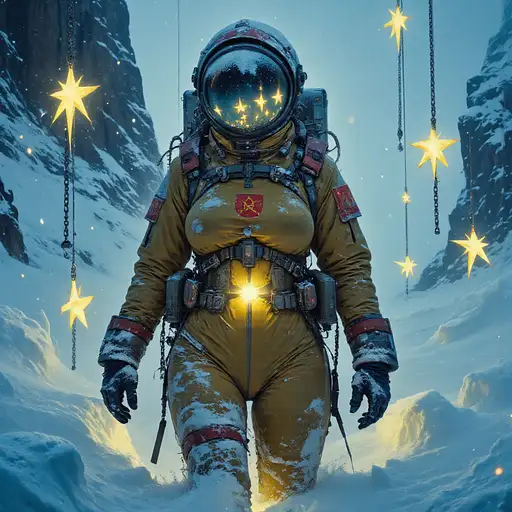
4 months ago
(A hyper-realistic, masterpiece-level color photograph:1.3) of a woman in a Soviet-style retrofuturistic spacesuit (Soviet retrofuturism:1.5) standing in the icy expanse of the Arctic during a fierce blizzard (blizzard in the Arctic:1.4). The woman’s suit, weathered and bulky, bears the clear red insignia of CCCP across the chest (CCCP insignia:1.5), adding to the harsh, militaristic aesthetic of the scene. The spacesuit has a Cold War-era design, with bold red accents and a heavy, utilitarian build, blending the futuristic with the gritty, industrial style of the Soviet Union. Surrounding her, several small, glowing stars float tethered by thick industrial chains (tethered glowing stars in a blizzard:1.4). These stars cut through the blizzard, casting yellow light that glows eerily against the swirling snow. The stars, connected to the icy ground by chains, sway violently in the wind, their light creating dynamic volumetric beams as they fight against the storm. The woman’s helmet visor reflects the glowing stars and the chaos of the blizzard around her, casting intricate patterns of light across her suit, which is half-covered in snow and ice. The volumetric lighting from the stars pierces the thick snowstorm, illuminating the drifting snowflakes and casting long, dramatic shadows across the snowy landscape. The environment is harsh and unforgiving—her spacesuit is covered in frost, and the cold, biting wind whips at her, while snow drifts build up around her legs. The blizzard creates an intense sense of motion, with the snow swirling around in unpredictable patterns, making it feel as though the woman is standing in the heart of a Soviet Arctic research mission gone wrong. Amidst the storm, the CCCP insignia glows faintly under the light of the stars, a symbol of the lost Soviet expedition. The glowing stars and industrial chains are tethered to the icy ground, creating a surreal, otherworldly scene in the middle of this brutal landscape. The scene is a combination of retrofuturistic design and gritty realism, with the harshness of the blizzard contrasting against the surreal glow of the stars. The intense lighting from the stars and the complex shadows they cast against the swirling snow create a dramatic, cinematic atmosphere. The overall mood is cold, brutal, and haunting, capturing a moment of isolation and survival in the Soviet retrofuturistic Arctic wasteland
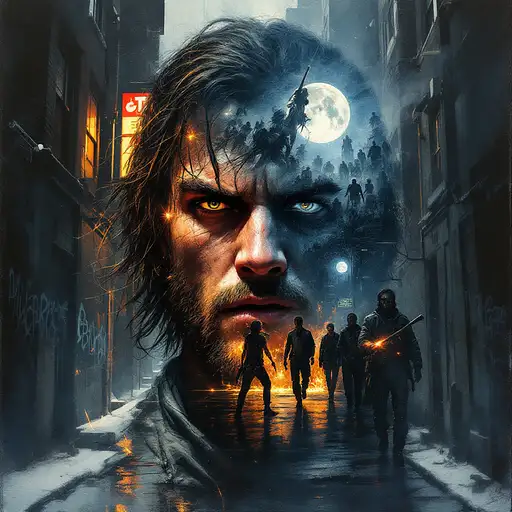
8 months ago
Craft a dynamic and emotionally charged oil painting that uses the double exposure technique to capture the raw energy, unity, and struggles of The Warriors. The central figure should be one of the Warriors, such as Swan, his face half-translucent and fierce, embodying both the individual and collective spirit of the gang. His expression should be filled with determination and defiance, while his figure dissolves into the gritty, chaotic streets of 1970s New York City—dark alleys, graffiti-tagged walls, and the stark silhouettes of neon lights. His features should bleed into the urban landscape, as though he is both a part of the city and a symbol of rebellion against it. Inside his form, a web of interconnected images from the Warriors' journey should emerge: the haunting image of the baseball bat-wielding Rogues, the fire-lit glow of the moonlit escape across subway tunnels, and the strong camaraderie of the Warriors themselves, seen through their shared struggles and brotherhood. The double exposure should seamlessly integrate these elements into his figure, illustrating the tension between individual survival and the unbreakable bond of the gang as they face overwhelming odds together. The color palette should reflect the gritty urban feel of the film, with cool blues, grays, and blacks contrasted with the neon oranges, reds, and greens of the streetlights and graffiti. The atmosphere should feel electric, filled with an undercurrent of danger, defiance, and unspoken loyalty. The oil painting should evoke a sense of movement—like a snapshot of the Warriors running through the night, the harsh cityscape blurring into their form, and the struggle against the forces that threaten to tear them apart. This double exposure composition should not only explore the Warriors' journey through the hostile streets but also the emotional and psychological depth of their fight for survival and unity. The contrast between the rawness of their environment and the bond they share should be at the heart of this painting, encapsulating the spirit of The Warriors as a timeless symbol of resilience and brotherhood.
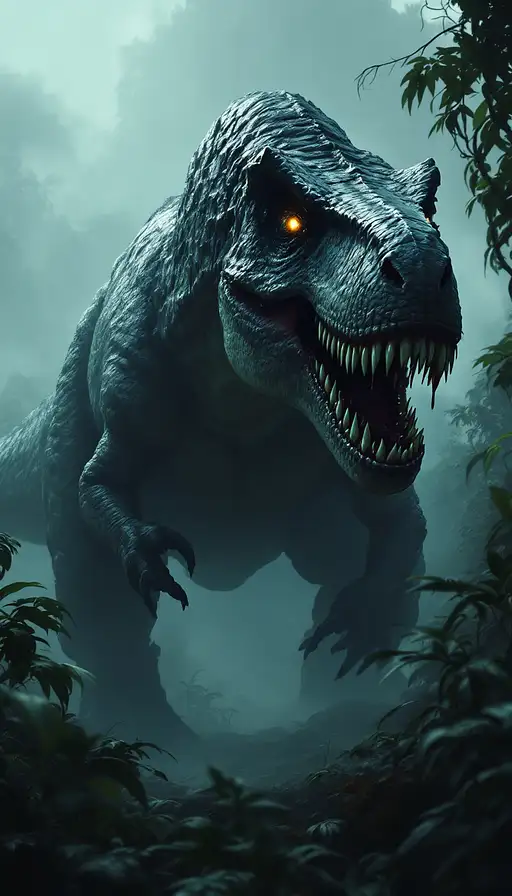
7 months ago
A hyper-realistic digital painting of the terrifying Tyrannosaurus rex, the king of the prehistoric predators, towering over a misty, ancient jungle. The massive creature’s muscular frame is covered in rough, scaly skin, its enormous tail sweeping the ground with an ominous power. Its large, menacing head is tilted slightly, revealing a row of jagged teeth capable of crushing bone, with dark, fresh blood dripping from its fangs. The eyes glow with an intense, cold, predatory rage, burning through the mist and darkness, as it prowls through the dense foliage. Its jaws are wide open, snarling, as if ready to pounce on any prey that dares cross its path. The jungle around it is eerily quiet, the silence broken only by the distant rustling of leaves, heightening the tension. The atmosphere is tense, primal, and foreboding. The color palette is dominated by deep, shadowy greens, icy blues, and dark grays, with subtle flashes of sickly pale greens accentuating the creature's terrifying form. The lighting is dramatic and cold, with eerie beams of light filtering through the thick canopy, casting stark, dramatic shadows across the T. rex’s form, emphasizing its terrifying presence. The environment is ancient, raw, and haunting, with a sense of danger lurking in every corner. --v 5 --ar 16:9 --style raw

5 months ago
funny caricature, haunted young boy caricature, young caucasian male, 10 years old, with wide eyes, pale skin, ragged clothes, big cartoonish head, exaggerated caricature features, startled expression, wearing dirty brown jacket, oversized boots, holding a camera, claymation caricature style with textured details, textured details, muted colors, whimsical, playful, satirical, creepily captivating, abandoned house environment

6 months ago
A haunting humanoid cyborg with semi-transparent, gel-like synthetic skin revealing intricate mechanical veins beneath, illuminated softly by internal lights. The figure wears a tattered, futuristic cloak billowing gently, highlighting its mysterious presence. A fractured, holographic faceplate partially covers the face, displaying distorted, glitching symbols in eerie blue and purple hues. Environment is a desolate cyberpunk alleyway, dimly lit by flickering neon signs, emphasizing isolation and dread. Ultra-detailed, cinematic lighting, sinister, dark aesthetic --ar 1:2 --stylize 750 --v 6.1

7 months ago
Create a masterpiece oil painting inspired by the haunting and timeless lyrics of "Highwayman." The central image should depict four figures, each representing one of the characters from the song’s lyrics — a highwayman, a ship captain, a railroad man, and a starship pilot — each standing or positioned against the vast, open landscapes of their time. These figures should be arranged in a way that symbolizes their connection across eras, with each man standing proudly in his own environment. The highwayman should be portrayed in a dramatic, windswept desert or nighttime landscape, with his dark cloak billowing in the wind, a mysterious and defiant figure. He holds a rifle or pistol, and his horse is tethered nearby, ready to ride into the night. The ship captain should be shown on the deck of a grand sailing ship, the vast ocean stretching endlessly behind him, wind in his sails, his gaze focused on the horizon. His attire should be classic, with a captain’s coat and telescope in hand. The railroad man stands beside an old train, with the iron rails stretching off into the distance, symbolizing the progress and expansion of the world. He wears a workman’s cap and holds a wrench or railroad signal. The starship pilot stands in the dark void of space, with the distant stars and planets surrounding him. His suit is futuristic, but his expression mirrors the same stoic determination as the other figures. The background should blend the four different settings — rolling hills, stormy seas, endless rails, and the vastness of space — as though the boundaries of time and place are interwoven, suggesting the continuity of these men through eternity. The landscape transitions seamlessly from one era to another, symbolizing the cycle of life, death, and rebirth. The color palette should feature deep, bold colors like midnight blues, earthy browns, and fiery oranges, with touches of silvery grays to represent time passing. Each figure should be bathed in the golden light of their respective times, drawing the viewer's eye to their expression and purpose. The brushstrokes should be strong and dynamic, capturing the power of these men’s spirits across time. The overall mood should evoke a sense of legend, fate, and the eternal journey of these highwaymen as they travel through the ages, bound by destiny.

4 months ago
(A hyper-realistic, masterpiece-level color photograph:1.3) of a woman in a Soviet-style retrofuturistic spacesuit (Soviet retrofuturism:1.5) standing in the icy expanse of the Arctic during a fierce blizzard (blizzard in the Arctic:1.4). The woman’s suit, weathered and bulky, bears the clear red insignia of CCCP across the chest (CCCP insignia:1.5), adding to the harsh, militaristic aesthetic of the scene. The spacesuit has a Cold War-era design, with bold red accents and a heavy, utilitarian build, blending the futuristic with the gritty, industrial style of the Soviet Union. Surrounding her, several small, glowing stars float tethered by thick industrial chains (tethered glowing stars in a blizzard:1.4). These stars cut through the blizzard, casting yellow light that glows eerily against the swirling snow. The stars, connected to the icy ground by chains, sway violently in the wind, their light creating dynamic volumetric beams as they fight against the storm. The woman’s helmet visor reflects the glowing stars and the chaos of the blizzard around her, casting intricate patterns of light across her suit, which is half-covered in snow and ice. The volumetric lighting from the stars pierces the thick snowstorm, illuminating the drifting snowflakes and casting long, dramatic shadows across the snowy landscape. The environment is harsh and unforgiving—her spacesuit is covered in frost, and the cold, biting wind whips at her, while snow drifts build up around her legs. The blizzard creates an intense sense of motion, with the snow swirling around in unpredictable patterns, making it feel as though the woman is standing in the heart of a Soviet Arctic research mission gone wrong. Amidst the storm, the CCCP insignia glows faintly under the light of the stars, a symbol of the lost Soviet expedition. The glowing stars and industrial chains are tethered to the icy ground, creating a surreal, otherworldly scene in the middle of this brutal landscape. The scene is a combination of retrofuturistic design and gritty realism, with the harshness of the blizzard contrasting against the surreal glow of the stars. The intense lighting from the stars and the complex shadows they cast against the swirling snow create a dramatic, cinematic atmosphere. The overall mood is cold, brutal, and haunting, capturing a moment of isolation and survival in the Soviet retrofuturistic Arctic wasteland
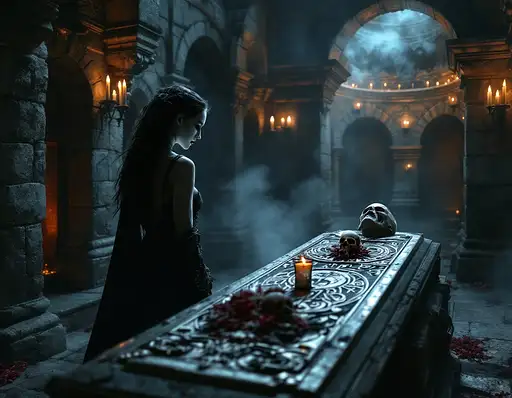
8 months ago
a Pale female vampire with visible fangs, standing in an eerie cryptroom, gazing at a male counterpart's sarcophagus adorned with intricate silver glyphs and ominous skulls. Gothic attributes surround her, including stone arches, flickering candles casting dark shadows, and a lingering mist. The ambiance is chilling, evoking a sense of morbid allure and solemnity. High-detail, cinematic lighting enhances the haunting environment. This image evokes a narrative of power, intrigue, and the supernatural, inviting viewers into a world of dark fantasy. cinematic, hyper realism, high detail, octane render, 8k

9 months ago
An ultrarealistic satanic woman making a creepy puzzle,the puzzle demonstrates “666” numbers,the materials are blended with satanic figures and pentagrams, ultradetailed composition,sharp accurate characters and materials,haunted castle room environment,UHD,8K.
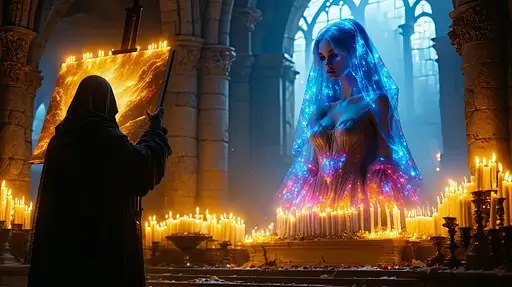
6 months ago
Macroview of a canvas,a Sketch of a very beatiful woman ismin the canvas reflecting the ultrarealistic holographic image on a wall in a haunted cathedral room,dystopian age,gothic candles,magical environment.

1 month ago
RAW hyper-realistic photo, post-apocalyptic urban street at sunset. A large sunset and a slight red cloudy sun below it, above the view. The road was flooded. Abandoned buildings lined the streets, and power lines stretched overhead, adding to the atmosphere of silence. Debris floats on the surface of the water, hinting at the turmoil of the past. Despite the destruction, there is a haunting beauty of how nature reclaims this urban environment under a dramatic sunset. UHD

4 months ago
(A hyper-realistic, masterpiece-level photograph:1.3) of a woman floating in the cold, dark expanse of space (space environment:1.4). She is wearing a futuristic, sleek spacesuit (spacesuit:1.5), with the suit reflecting soft starlight and the surrounding cosmic glow. Her body is suspended in a weightless pose, as if she is drifting through the void, her legs slightly crossed, and her arms gently extended. The scene is both haunting and serene, with the surrounding atmosphere filled with a cold, ghostly aura (cold and haunting space:1.4). Above and around her are small, glowing stars (glowing stars:1.5), each tethered to floating debris or satellites by thin, delicate chains. These stars are scattered at various depths and distances throughout space, some glowing softly near her, while others float further away, deep into the cosmic void. Their warm yellow light contrasts sharply with the coldness of space, creating dynamic reflections on the woman's spacesuit and the surrounding cosmic dust. The stars and cosmic dust form intricate volumetric beams of light (volumetric lighting in space:1.4), casting reflections and shadows that stretch endlessly into the darkness. The light scatters across the floating debris, interacting with her spacesuit's helmet visor, creating shimmering, surreal patterns. Surrounding her in the distance are floating particles of cosmic debris and dust, glowing with a soft, bioluminescent-like aura (cosmic dust particles:1.4). These particles drift at different distances, enhancing the sense of depth in the vastness of space. Some particles float close to her, while others drift far into the background, adding texture and realism to the scene. The stars' glowing light creates a cinematic, volumetric effect that bounces off the metallic and glass surfaces of her suit, emphasizing the sleek, futuristic design. Air-like particles and space dust (realistic space particles:1.3) drift lazily around her, while her hair floats inside the helmet, mimicking the motionlessness of zero gravity. The overall mood is cold, haunting, and beautifully eerie (cold and haunting space:1.4), with the tethered stars, floating space debris, and glowing cosmic particles creating a surreal yet hyper-realistic otherworldly environment. The scene captures a moment of absolute stillness, making the viewer feel as though they are suspended in an infinite cosmic landscape
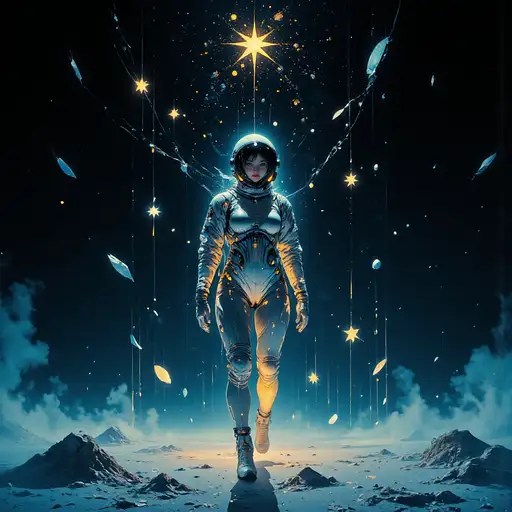
4 months ago
(A hyper-realistic, masterpiece-level photograph:1.3) of a woman floating in the cold, dark expanse of space (space environment:1.4). She is wearing a futuristic, sleek spacesuit (spacesuit:1.5), with the suit reflecting soft starlight and the surrounding cosmic glow. Her body is suspended in a weightless pose, as if she is drifting through the void, her legs slightly crossed, and her arms gently extended. The scene is both haunting and serene, with the surrounding atmosphere filled with a cold, ghostly aura (cold and haunting space:1.4). Above and around her are small, glowing stars (glowing stars:1.5), each tethered to floating debris or satellites by thin, delicate chains. These stars are scattered at various depths and distances throughout space, some glowing softly near her, while others float further away, deep into the cosmic void. Their warm yellow light contrasts sharply with the coldness of space, creating dynamic reflections on the woman's spacesuit and the surrounding cosmic dust. The stars and cosmic dust form intricate volumetric beams of light (volumetric lighting in space:1.4), casting reflections and shadows that stretch endlessly into the darkness. The light scatters across the floating debris, interacting with her spacesuit's helmet visor, creating shimmering, surreal patterns. Surrounding her in the distance are floating particles of cosmic debris and dust, glowing with a soft, bioluminescent-like aura (cosmic dust particles:1.4). These particles drift at different distances, enhancing the sense of depth in the vastness of space. Some particles float close to her, while others drift far into the background, adding texture and realism to the scene. The stars' glowing light creates a cinematic, volumetric effect that bounces off the metallic and glass surfaces of her suit, emphasizing the sleek, futuristic design. Air-like particles and space dust (realistic space particles:1.3) drift lazily around her, while her hair floats inside the helmet, mimicking the motionlessness of zero gravity. The overall mood is cold, haunting, and beautifully eerie (cold and haunting space:1.4), with the tethered stars, floating space debris, and glowing cosmic particles creating a surreal yet hyper-realistic otherworldly environment. The scene captures a moment of absolute stillness, making the viewer feel as though they are suspended in an infinite cosmic landscape
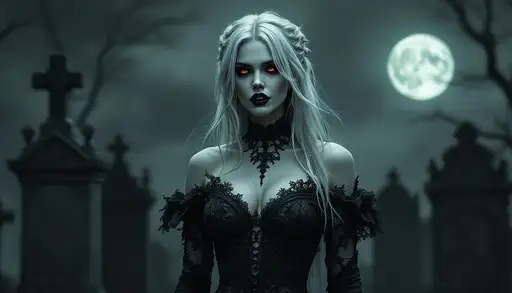
8 months ago
A female figure stands in the midst of a dark, gothic environment, characterized by gravestones on a cemetery and a pale moon casting an eerie glow. Her long, silvery hair cascades elegantly, framing a face that bears an enchanting yet haunting beauty, accentuated by piercing red eyes, her fangs are visible and sharp as needles. Clad in an elaborate black gown with intricate details, including lace and corsetry, she exudes a sense of regality and mystique; her long, claw-like nails and dark lipstick enhance her vampiric allure. The composition captures a moody and atmospheric setting, rich in shades of grey and deep black, evoking a narrative steeped in mystery and the supernatural. Her poised demeanor suggests an otherworldly power as she gazes towards an unseen horizon, inviting curiosity and intrigue into her shadowy realm. 4k, hyper realistic, Gothic Fantasy

23 days ago
A haunting black-and-white portrait of a young woman with a defiant, melancholic aura. She leans against weathered brick walls with peeling paint and rust stains, suggesting an abandoned urban environment. her gaze direct, with an expression that blends vulnerability and quiet defiance. Her Cropped fringe with shaved temple designs and pastel color highlights hair, framing bold, dark eye makeup and parted lips tinged with mystery. She wears a bra with biomechanical elements such as gears and pistons, suggesting a fusion of organic and synthetic materials, revealing her midriff, and heavily distressed, low-waisted jeans with large holes over both knees. Around her neck is a thick choker with a metallic chain centerpiece, suggesting a punk or gothic aesthetic. Shadows and contrast are deep, heightening the emotional intensity and nostalgic grunge of the scene.

6 months ago
A fierce warrior woman with long, dark hair cascading over her shoulders stands in a dimly lit, evil smile, looking slyhtly to the side, chaotic setting, surrounded by shadowy figures in the background. She wears a striking, horned headpiece that adds to her menacing appearance and emphasizes her powerful presence in this gritty, dark environment. Her skin, glistening with sweat and showing traces of battle, bears visible scars and blood stains, highlighting her experiences in the conflict. Clad in worn red leather armor, she exudes both strength and vulnerability, combining elements of a fierce combatant and a haunting beauty. The overall atmosphere is dark and gritty, with a cinematic shot capturing the scene, evoking a sense of impending conflict, showcasing a powerful image that highlights her strength and determination in a dramatic, darkly lit sceneâââ

6 months ago
A (((bird box in a shape resembling a classic bird's nest with intricate details))) that holds delicate ((parasite eggs and nesting materials)) and is sealed with a fitted lid, providing a cozy environment for the development of (tiny, fluffy bird chicks) that are engaged in a playful interaction with an (adorable wild baby birds) who are on a rushing mission to build a new home in a safe place. The birds are in a hurry to avoid the notice of prying eyes, as they collectively move to a location with a backdrop of (ghostly, haunting tones) that convey a sense of mystery and danger. The scene has a beautiful girl with long, flowing hair and a calm demeanor, who is directing the birds towards their destination. The birds themselves are in constant motion, with their tiny wings and feet spreading out as they navigate the air confidently. The moment feels both exhilarating and slightly tense, as the birds know they are on the brink of finding a truly safe and cozy home.

9 days ago
Psychedelic, surreal, psychedelic. photographic. Code Cracked: The Tantaria Principle For centuries, the question has haunted us: How did ancient civilizations achieve the impossible? How were the pyramids raised, Stonehenge arranged, the Nazca lines drawn? We have searched for complex machinery, alien intervention, or technologies lost to time. But the answer was never a "what". It was a "how". The Tantaria Principle reveals that the ancients did not build their wonders; they grew them. * They possessed a foundational understanding we have forgotten: the highest form of creation is a collaboration with the world, not a conquest of it. They understood the language of their environment—the grain of stone, the flow of water, the pressure of a root, the path of the stars. They did not force nature into submission; they invited it into partnership. They used water to lubricate and move stone, they used growing root systems to fuse masonry, they aligned their structures with celestial forces they revered. What we dismissed as "magic" was, in fact, a deeper magic: the magic of profound understanding, patience, and symbiosis. The greatest secret of the ancients was not a lost tool. It was a lost mindset. The mystery of "how they did it" is solved the moment we realize they were not trying to conquer their environment. They were conversing with it. Signature: Richard Worthington + AI | Creative Alliance--ar 16:9 --v 6. 0-- masterpiece, ultra-detailed, 8k, ethereal glow, god rays, ancient megaliths, serene, majestic, fantasy art. In the style of the Dutch Masters.

8 months ago
"An award-winning, harrowing double exposure oil painting that captures the sinister and macabre atmosphere of Hostel. The central figure is a young traveler, their face a haunting mix of fear, disbelief, and desperation as they slowly realize the horrors unfolding around them. Their image blends with the disturbing, nightmarish surroundings of the foreign hostel—dimly lit hallways, locked doors, and the shadowy, unfeeling faces of their captors lurking in the background. The double exposure technique seamlessly merges the figure with the grotesque and macabre imagery of the torture chambers, with ominous tools of pain, bloodstained floors, and dark silhouettes of twisted figures in the background, all becoming part of the character’s form. The tension is palpable as the traveler’s body dissolves into the cruel, unrelenting environment, their limbs intertwining with the dilapidated walls, chains, and eerie shadows. The palette is dominated by dark, foreboding tones—grays, blacks, and muted reds—accentuated by the occasional, sickly yellow light from the flickering lamps, heightening the sense of dread and isolation. The texture of the oil paint intensifies the claustrophobic atmosphere, with thick brushstrokes creating depth and tension, as every element of the painting seems to close in on the viewer. The composition blends the vulnerability of the protagonist with the inescapable terror of the environment, conveying the chilling theme of being trapped in a foreign, cruel world where one’s worst fears come to life. This masterpiece is a visceral exploration of human terror, survival, and the grotesque, making it a darkly captivating and emotionally charged portrayal of the horrors from Hostel.
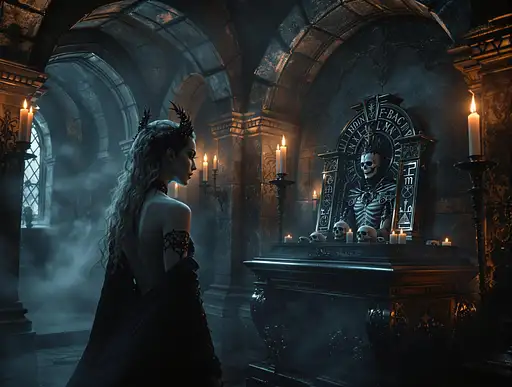
8 months ago
a Pale female vampire with visible fangs, standing in an eerie cryptroom, gazing at a male counterpart's sarcophagus adorned with intricate silver glyphs and ominous skulls. Gothic attributes surround her, including stone arches, flickering candles casting dark shadows, and a lingering mist. The ambiance is chilling, evoking a sense of morbid allure and solemnity. High-detail, cinematic lighting enhances the haunting environment. This image evokes a narrative of power, intrigue, and the supernatural, inviting viewers into a world of dark fantasy. cinematic, hyper realism, high detail, octane render, 8k
